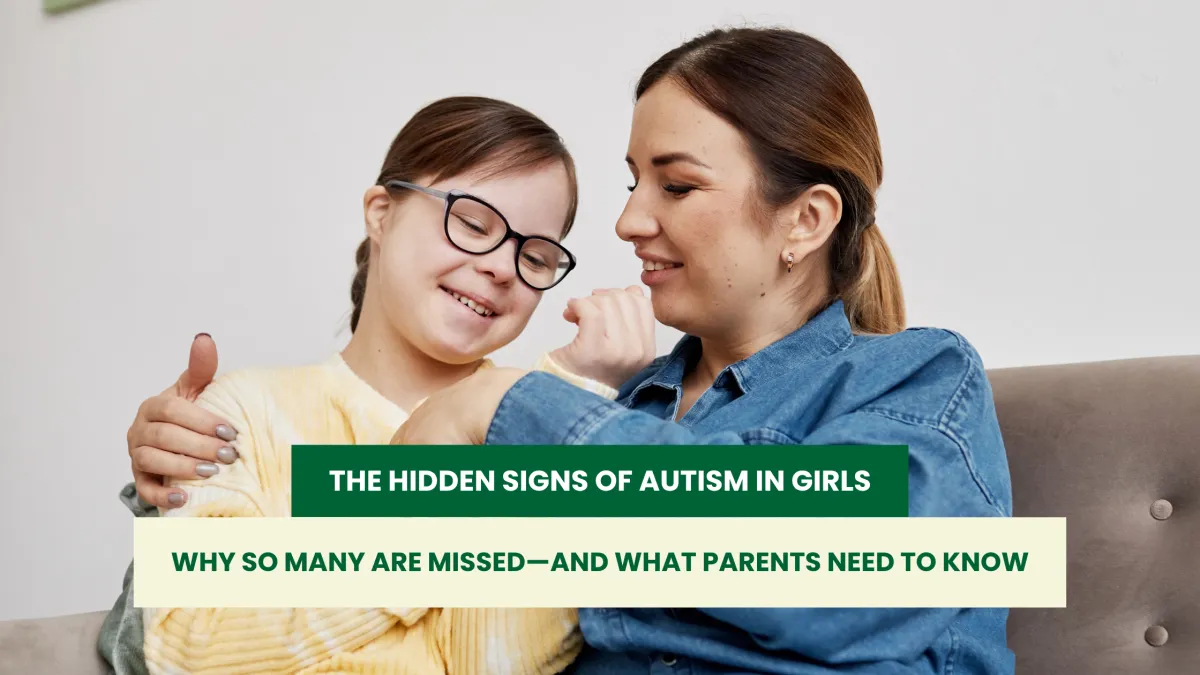
The Hidden Signs of Autism in Girls
You’re told your daughter is just shy. Sensitive. Maybe a little dramatic.
She’s polite, makes eye contact, and gets good grades. But something still feels… off.
So why hasn’t anyone mentioned autism?
Here’s the truth: autism in girls doesn’t always look like what we’ve been taught to expect.
And because of that, thousands of girls go undiagnosed—or misdiagnosed—for years.
As a child psychologist who specializes in neurodivergent kids, I’ve seen girls come into my office with labels like “anxious,” “emotional,” or “difficult.” But when we dig deeper, what we often find is a brain that’s wired for autistic strengths—and struggling to survive in a world that doesn’t recognize them.
In this article, we’ll unpack the hidden signs of autism in girls, explore why they’re so often overlooked, and walk through steps parents can take to get clarity and support.
💡 Why Autism in Girls Gets Missed
Most autism research has been conducted on boys, and most diagnostic tools are based on male presentations of autism (Loomes et al., 2017). But autism expresses differently in girls—especially those with average to high verbal skills.
Here’s why girls tend to fly under the radar:
They mask—copying behaviors from others to fit in
They internalize distress instead of acting out
Their special interests may look more “socially acceptable”
They’re often misdiagnosed with anxiety, depression, or even borderline personality disorder as teens or adults
This doesn’t mean their autism is milder. It just means it’s better camouflaged—and that comes at a cost.
🔍 7 Hidden Signs of Autism in Girls
These aren’t the traits you’ll always find in a diagnostic checklist—but they’re patterns I’ve seen over and over again in autistic girls:
1. 🔄 Masking and Mimicking
Your daughter might seem socially adept—until you realize she’s scripting interactions or copying others without understanding them.
Masking is exhausting. It can lead to burnout, identity confusion, and emotional crashes after social situations.
2. 💔 Intense Emotional Sensitivity
Autistic girls often feel deeply—injustice, exclusion, criticism. But their emotions may be dismissed as being “too sensitive” or “too much.”
They may:
Cry easily
Worry about being liked
Take social slights very personally
3. 🧸 Social Camouflage
Many autistic girls have friends—but often it’s surface-level or one-sided. They may prefer one-on-one interactions or feel like they’re “on stage” in groups.
You might notice:
Intense, short-lived friendships
Copying slang or dress codes to fit in
Anxiety around peer dynamics
4. 🌪 Internalized Meltdowns
Instead of lashing out, autistic girls often implode. You’ll see:
Frequent stomachaches or headaches
Quiet withdrawal
Emotional shutdowns or panic attacks
They might hold it together all day and fall apart at home.
5. 🌟 Special Interests That Fly Under the Radar
Autistic girls often have intense passions, but they’re socially “acceptable”:
Animals, Harry Potter, horses, K-Pop
Drawing characters over and over
Writing detailed stories or roleplaying
These can be just as intense as stereotypical interests in trains or numbers—but often dismissed as normal “girl obsessions.”
6. 😶 Difficulty with Social Nuance
Girls may memorize social scripts but still struggle with:
Sarcasm
Group conversations
Knowing when to join or leave a conversation
They may “float” socially— but are not truly connected.
7. 🧠 Overthinking and Perfectionism
Autistic girls may be rule followers and high achievers, driven by anxiety rather than confidence.
You may see:
Extreme frustration over mistakes
Fear of disappointing others
“Good girl” behavior masking internal overwhelm
💬 But She Makes Eye Contact…
Yes, and that’s okay.
Autism doesn’t mean a child can’t make eye contact, have friends, or do well in school.
It means their brain processes the world differently—and that difference impacts how they experience, cope, and connect.
👀 Why Early Identification Matters
When girls are missed, they often:
Internalize that something is “wrong” with them
Experience anxiety, depression, or eating disorders by adolescence
Burn out from years of masking
Getting clarity isn’t about putting your child in a box.
It’s about giving them language, validation, and support.
✅ What You Can Do as a Parent
1. Trust Your Gut
If you sense something deeper than anxiety or social awkwardness, explore it.
Don’t let “She seems fine” stop you from seeking answers.
2. Find a Clinician Who Gets It
Not all evaluators are trained to recognize autism in girls. Look for someone with:
A neurodiversity-affirming approach
Experience assessing subtle presentations in girls
Willingness to consider the whole picture, not just test scores
3. Focus on Support, Not Labels
Whether or not your child receives a diagnosis, support is key:
Occupational therapy (especially sensory integration)
Therapy that focuses on emotional regulation and identity
Social skills support—but tailored, not conformity-based
Validation: “It’s okay to be different. Different isn’t broken.”
❤️ Final Thoughts
Autistic girls are often the quiet fighters—coping in silence, smiling through confusion, striving for perfection while feeling like outsiders.
If your daughter is one of them, she doesn’t need to change to fit in.
She needs the world to see her as she really is—intelligent, sensitive, brave, and whole.
Early recognition isn’t about limiting her.
It’s about helping her understand her brilliance before the world convinces her it’s a flaw.
📚 References
Loomes, R., Hull, L., & Mandy, W. P. (2017). What is the male-to-female ratio in autism spectrum disorder? A systematic review and meta-analysis. Journal of the American Academy of Child & Adolescent Psychiatry, 56(6), 466–474. https://doi.org/10.1016/j.jaac.2017.03.013
Hiller, R. M., Young, R. L., & Weber, N. (2016). Sex differences in autism spectrum disorder based on DSM-5 criteria: Evidence from clinician and teacher reporting. Journal of Abnormal Child Psychology, 44(6), 1311–1322. https://doi.org/10.1007/s10802-015-0101-1
Hull, L., Mandy, W., & Petrides, K. V. (2017). Behavioural and cognitive sex/gender differences in autism spectrum condition and typically developing males and females. Autism, 21(6), 706–727. https://doi.org/10.1177/1362361316669087
